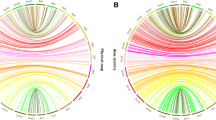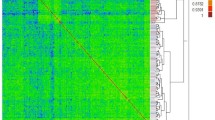Abstract
There is an immediate need for a high-density genetic map of cotton anchored with fiber genes to facilitate marker-assisted selection (MAS) for improved fiber traits. With this goal in mind, genetic mapping with a new set of microsatellite markers [comprising both simple (SSR) and complex (CSR) sequence repeat markers] was performed on 183 recombinant inbred lines (RILs) developed from the progeny of the interspecific cross Gossypium hirsutum L. cv. TM1 × Gossypium barbadense L. Pima 3-79. Microsatellite markers were developed using 1557 ESTs-containing SSRs (≥10 bp) and 5794 EST-containing CSRs (≥12 bp) obtained from ~14,000 consensus sequences derived from fiber ESTs generated from the cultivated diploid species Gossypium arboreum L. cv AKA8401. From a total of 1232 EST-derived SSR (MUSS) and CSR (MUCS) primer-pairs, 1019 (83%) successfully amplified PCR products from a survey panel of six Gossypium species; 202 (19.8%) were polymorphic between the G. hirsutum L. and G. barbadense L. parents of the interspecific mapping population. Among these polymorphic markers, only 86 (42.6%) showed significant sequence homology to annotated genes with known function. The chromosomal locations of 36 microsatellites were associated with 14 chromosomes and/or 13 chromosome arms of the cotton genome by hypoaneuploid deficiency analysis, enabling us to assign genetic linkage groups (LG) to specific chromosomes. The resulting genetic map consists of 193 loci, including 121 new fiber loci not previously mapped. These fiber loci were mapped to 19 chromosomes and 11 LG spanning 1277 cM, providing approximately 27% genome coverage. Preliminary quantitative trait loci analysis suggested that chromosomes 2, 3, 15, and 18 may harbor genes for traits related to fiber quality. These new PCR-based microsatellite markers derived from cotton fiber ESTs will facilitate the development of a high-resolution integrated genetic map of cotton for structural and functional study of fiber genes and MAS of genes that enhance fiber quality.




Similar content being viewed by others
References
Anderson JA, Churchill GA, Autrique JE, Tanksley SD, Sorrells ME (1993) Optimizing parental selection for genetic linkage map. Genome 36:181–186
Arpat AB, Waugh M, Sullivan JP, Gonzales M, Frisch D, Main D, Wood T, Leslie A, Wing RA, Wilkins TA (2004) Functional genomics of cell elongation in developing cotton fibers. Plant Mol Biol 54:911–929
Arumuganathan K, Earle ED (1991) Nuclear DNA content of some important plant species. Plant Mol Biol Rep 9:208–218
Ayers NM, McClung AM, Larkin PD, Bligh HFJ, Jones CA, Park WD (1997) Microsatellite and single nucleotide polymorphism differentiate apparent amylase classes in an extended pedigree of US rice germplasm. Theor Appl Genet 94:773–781
Botstein D, White RL, Skolnick M, Davis RW (1980) Construction of a genetic linkage map in man using restriction fragment length polymorphism. Am J Hum Genet 32:314–331
Brinkmann B, Junge A, Meyer E, Wiegand P (1998a) Population genetic diversity in relation to microsatellite heterogeneity. Hum Mutat 11:135–144
Brinkmann B, Klintschar M, Neuhuber F, Hühne J, Rolf B (1998b) Mutation rate in human microsatellites: influence of the structure and length of the tandem repeat. Am J Hum Gene 62:1408–1415
Bull LN, Pabon-Pena CR, Freimer NB (1999) Compound microsatellite repeats: practical and theoretical features. Genome Res 9:830–838
Burr B, Burr FA, Thompson KH, Albertson MC, Stuber CW (1988) Gene mapping with recombinant inbreds in maize. Genetics 118:519–526
Cardle L, Ramsay L, Milbourne D, Macaulay M, Marshall D, Waugh R (2000) Computational and experimental characterization of physically clustered simple sequence repeats in plants. Genetics 156:847–854
Chee PW, Rong J, Williams-Coplin D, Schulze SR, Paterson AH (2004) EST derived PCR-based markers for functional gene homologues in cotton. Genome 47:449–462
Chin ECL (1996) Maize simple repetitive DNA sequences: abundance and allele variation. Genome 156:847–854
Churchill GA, Doerge RW (1994) Empirical threshold values for quantitative traits mapping. Genetics 138:963–971
Cordeiro GM, Casu R, McIntyre CL, Manners JM, Henry RJ (2001) Microsatellite markers from sugarcane (Saccharum spp.) ESTs cross transferable to Erianthus and Sorghum. Plant Sci 160:1115–1123
Eujayl I, Sorrells ME, Wolters P, Baum M, Powell W (2002) Isolation of EST-derived microsatellite markers for genotyping the A and B genomes of wheat. Theor Appl Genet 104:399–407
Garza JC, Freimer NB (1996) Homoplasy for size at microsatellite loci in humans and chimpanzees. Genome Res 6:211–217
Gupta PK, Balyan HS, Sharma PC, Ramesh B (1996) Microsatellites in plants: a new class of molecular markers. Curr Sci 70:45–53
Haldane JB, Waddington CH (1931) Inbreeding and linkage. Genetics 16:357–374
Han Z, Guo W, Song X, Zhang T (2004) Genetic mapping of EST-derived microsatellites from the diploid Gossypium arboreum in allotetraploid cotton. Mol Genet Genomics 272:308–327
Ji SJ, Lu YC, Feng JX, Wei G, Li J, Shi YH, Fu Q, Liu D, Luo JC, Zhu YX (2003) Isolation and analyses of genes preferentially expressed during early cotton fiber development by subtractive PCR and cDNA array. Nucleic Acids Res 31:2534–2543
Jiang C, Wright RJ, Woo SS, DelMonte TA, Paterson AH (2000) QTL analysis of leaf morphology in tetraploid Gossypium (cotton). Theor Appl Genet 100:409–418
Kohel RJ, Yu J, Park Y-H, Lazo GR (2001) Molecular mapping and characterization of traits controlling fiber quality in cotton. Euphytica 121:163–172
Ky CL, Barre P, Lorieux M, Trouslot P, Akaffou S, Louarn J, Charrier A, Hamon S, Noirot M (2000) Interspecific genetic linkage map, segregation distortion and genetic conversion in coffee. Theor Appl Genet 101:669–676
Lacape J-M, Nguyen T-B, Thibivilliers S, Bojinov B, Courtois B. Cantrell RG (2003) A combined RFLP-SSR-AFLP map of tetraploid cotton based on a Gossypium hirsutum × Gossypium barbadense backcross population. Genome 46:612–626
Lin L, Jin L, Lin X, Voros A, Underhill P, Mignot E (1998) Microsatellite single nucleotide polymorphisms in the HLA-DQ region. Tissue Antigens 52:9–18
Liu S, Saha S, Stelly D, Burr B, Cantrell RG (2000) Chromosomal assignment of microsatellite loci in cotton. J Hered 91:326–332
Lu H, Romero-Severson J, Bernardo R (2002) Chromosomal regions associated with segregation distortion in Maize. Theor Appl Gent 105:622–628
Lucas M, Munoz C, Pintado E, Solano F (1997) Highly informative single-stranded conformation polymorphism (SSCP) of short tendem repeats in DNA identification. J Forensic Sci 42:118–120
Mei M, Syed NH, Gao W, Thaxton PM, Smith CW, Stelly DM, Chen ZJ (2004) Genetic mapping and QTL analysis of fiber-related traits in cotton (Gossypium). Theor Appl Genet 108:280–291
Metzgar D, Bytof J, Wills C (2000) Selection against frameshift mutation limits macrosatellite expansion in coding DNA. Genome Res 10:72–80
Morgante M, Hanafey M, Powell W (2002) Microsatellites are preferentially associated with nonrepetitive DNA in plant genomes. Nature Genet 30:194–200
Nikaido A, Yoshimaru H, Tsumura Y, Suyama Y, Murai M, Nagasaka K (1999) Segregation distortion for AFLP markers in Cryptomeria japonica. Genes Genet Syst 74:55–59
Nguyen TB, Giband M, Brottier P, Risterucci A-M, Lacape J-M (2004) Wide coverage of the tetraploid cotton genome using newly developed microsatellite markers. Theor Appl Genet 109:167–175
Paterson AH, Saranga Y, Menz M, Jiang C, Wright RJ (2003) QTL analysis of genotype × environmental interactions affecting cotton fiber quality. Theor Appl Genet 106:384–396
Percival AE, Wendel JF, Stewart JM (1999) Taxonomy and gemplasm resources. In: Smith CW, Cothren JT (eds) Cotton: origin, history, technology, and production. Wiley, New York, pp 33–63
Qureshi SN, Saha S, Kantety RV, Jenkins JN (2004) EST-SSR: a new class of genetic markers in cotton. J Cotton Sci 8:112–123
Reddy OUK, Pepper AE, Abdurakhmonov I, Saha S, Jenkins JN, Brooks T, Bolek Y, El-Zik KM (2001) New dinucleotide and trinucleotide microsatellite marker resources for cotton genome research. J Cotton Sci 5:103–113
Reinisch A, Dong J-M, Brubaker C, Stelly D, Wendel J, Peterson A (1994) A detailed RFLP map of cotton (Gossypium hirsutum × G. barbadense): chromosome organization and evolution in a disomic polyploid genome. Genetics 138:829–847
Rong J, et al (2004) A 3347-locus genetic recombination map of sequence-tagged sites reveals features of genome organization, transmission and evolution of cotton (Gossypium). Genetics 166:389–417
Saha S, Karaca M, Jenkins JN, Zipf AE, Reddy OUK, Kantety RV (2003) Simple sequence repeats as useful resources to study transcribed genes of cotton. Euphytica 130:355–364
Scott KD, Eggler P, Seaton G, Rossetto M, Ablett EM, Lee LS, Henry RJ (2000) Analysis of SSRs derived from grapes EST. Theor Appl Genet 100:723–726
Shen X, Guo W, Zhu X, Yuan Y, Yu JZ, Kohel RJ, Zhang T (2005) Molecular mapping of QTLs for qualities in three diverse lines in Upland cotton using SSR markers. 15:169–181
Stam P, Van Ooijen JW (1995) JoinMap™ Version 2.0: software for the calculation of genetic linkage maps. CPRO-DLO, Wageningen
Stelly DM (1993) Interfacing cytogenetics with the cotton genome mapping effort. In: Herber DJ, Richter DA (eds) Beltwide cotton conference, New Orleans, January 10–14, 1993. National Cotton Council of America, Memphis, pp 1545–1550
Subramanian S, Madgula VM, George R, Kumar S, Pandit MW, Singh L (2003) SSRD: simple sequence repeats database of the human genome. Comp Funct Genomics 4:342–345
Tautz D, Schotterer C (1994) Simple sequences. Curr Opin Genet 4:832–837
Temnykh S, Park WD, Ayres N, Cartinhour S, Hauck N, Lipovich L, Cho YG, Ishii T, McCouch SR (2000) Mapping and genome organization of microsatellite sequences in rice (Oryza sativa L.). Theor Appl Genet 100:697–712
Thiel T, Michalek W, Varshney RK, Graner A (2003) Exploiting EST databases for the development and characterization of gene-derived SSR-markers in barley (Hordeum vulgare L.). Theor Appl Genet 106:411–422
Ulloa M, Meredith WR Jr (2000) Genetic linkage map and QTL analysis of agronomic and fiber quality traits in an intraspecific population. J Cotton Sci 4:161–170
Ulloa M, Meredith WR Jr, Shapply ZW, Kahler AL (2002) RFLP genetic linkage maps from F2.3 populations and a joinmap of Gossypium hirsutum L. Theor Appl Genet 104:200–208
Ulloa M, Mc Stewart J, Garcia CE, Godoy AS, Gaytan MA, Acosta NS (2005a) Cotton genetic resources in the western states of Mexico: in situ conservation status and germplasm collection for ex situ preservation. Genet Resour Crop Evol, in press
Ulloa M, Saha S, Jenkins JN, Meredith WR, McCarty JC, Stelly MD (2005b) Chromosomal assignment of RFLP linkage groups harboring important QTLs on an intraspecific cotton (Gossypium hirsutum L.) joinmap. J Hered 96:132–144
Urquhart A, Kimpton CP, Downes TJ, Gill P (1994) Variation in short tandem repeat sequences—a survey of twelve microsatellite loci for use as forensic identification markers. Int J Leg Med 107:13–20
Van Ooijen JW, Maliepaard C (1996) MapQTL™ Version 3.0, sotfware for the calculation of QTL positions on genetic maps. Plant Research International, Wageningen, The Netherlands
Wang S, Basten CJ, Zeng ZB (2001–2004) Windows QTL Cartographer 2.0. Department of Statistics, North Carolina State University, Raleigh, NC
Weber JL (1990) Informativeness of human (dC-dA)n (dG-dT)n polymorphisms. Genomics 7:524–530
Wendel JF, Cronn RC (2003) Polyploidy and evolutionary history of cotton. Adv Agron 78:139–186
Wilkins TA, Arpat AB (2005) The cotton fiber transcriptome. Physiol Plant, in press
Wilkins TA, Arpat AB, Sickler BA (2005) Cotton fiber genomics: developmental mechanisms. Pflanzenschutz-Nachrichten 58:119–139
Acknowledgements
This research was supported, in part, by Cotton Incorporated Project Nos. 03-398 and 03-321CA (to M.U.) and the NSF Plant Genome Research Program (DBI 9872630 to T.A.W). We would like to thank James Frelichowski, Ravinder Gill and Gregory Allen for running agarose gels. We would like to gratefully acknowledge Cotton Inc. for its support on this project. We also would like to acknowledge the U.S.-Egypt Joint Cotton Project (BIO7-001-015) for providing partial support of Magdy S. Alabady at the USDA-ARS, WICS, Cotton Enhancement Program.
Author information
Authors and Affiliations
Corresponding author
Additional information
Communicated by R. Hagemann
Names are necessary to report factually on available data, however, the USDA neither guarantees nor warrants the standard of products or service, and the use of the name by the USDA implies no approval of the products or service to the exclusion of others that may also be suitable.
Electronic supplementary material
Rights and permissions
About this article
Cite this article
Park, YH., Alabady, M.S., Ulloa, M. et al. Genetic mapping of new cotton fiber loci using EST-derived microsatellites in an interspecific recombinant inbred line cotton population. Mol Genet Genomics 274, 428–441 (2005). https://doi.org/10.1007/s00438-005-0037-0
Received:
Accepted:
Published:
Issue Date:
DOI: https://doi.org/10.1007/s00438-005-0037-0




